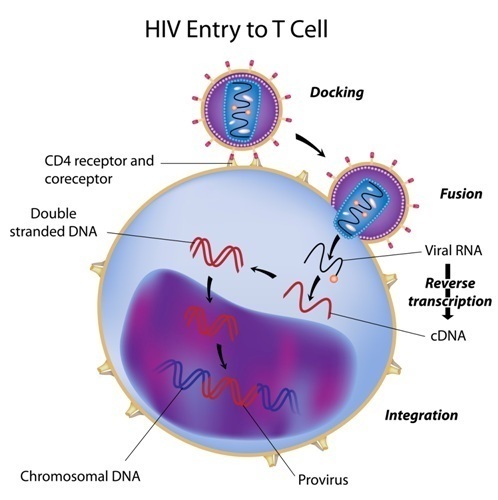
 Data Structure
Data Structure Networking
Networking RDBMS
RDBMS Operating System
Operating System Java
Java MS Excel
MS Excel iOS
iOS HTML
HTML CSS
CSS Android
Android Python
Python C Programming
C Programming C++
C++ C#
C# MongoDB
MongoDB MySQL
MySQL Javascript
Javascript PHP
PHP
- Selected Reading
- UPSC IAS Exams Notes
- Developer's Best Practices
- Questions and Answers
- Effective Resume Writing
- HR Interview Questions
- Computer Glossary
- Who is Who
What Is Reverse Transcription and What Is the Role of Reverse Transcriptase
Introduction
The central dogma of molecular biology stated the utilization of genetic information. The first process is replication, the copying of parental DNA to form daughter DNA molecules with identical nucleotide sequences. The second process is transcription, which is the process by which a genetic message present in the DNA is copied into an RNA. The third process involves the translation of messages on RNA to a polypeptide chain with a particular amino acid in the ribosomes.
With all these processes one more process takes place in viruses where genetic material is RNA, in such organisms a complementary DNA (cDNA) is formed from a template RNA by an enzyme called reverse transcriptase.
Steps Involved in Reverse Transcription
The process of reverse transcription in viruses involves the following step ?
First Transfer RNA which is cell-specific acts as a primer and anneals itself to the complementary part of the viral genome and this part is known as the primer binding site (PBS).
In the next step the complementary DNA binds to a non-coding region which is known as U5 region and at the same time to a direct repeat which occurs at both the ends of RNA molecule and this region is known as the R- region.

RNase H which is a domain found on the reverse transcriptase enzyme helps in the degradation and subsequent removal of the 5' U5 and R regions of the RNA.
Once the U5 and R regions are degraded the primer jumps to the 3' end of viral RNA and now the cDNA which is newly synthesized.
In the next step extension of the first strand of complementary DNA take place and there is a degradation of RNA takes place by RNase H.
Hybridization of the primer binding site of the second strand takes place with the primer binding site of the first strand at the complementary sequences.
Enzyme integrase incorporates the extended strands into the host genome. Various infection processes like cell lysis and integration into the host genome or remaining dormant are caused by the DNA duplex generated.
Enzyme Reverse Transcriptase
Most of the viruses that are the cause of infection in animals and other organisms will contain RNA-dependent DNA polymerase which is also known as Reverse transcriptase.
Structure of Reverse Transcriptase
Reverse transcriptase is made up of two subunits ? and ?, hence it is a heterodimer, with ? subunit having a molecular weight of 65kDa and the ?subunit having a molecular weight of 90kDa.
Just like the Klenow fragment structure the ? subunit has three components namely finger, palm and thumb.
Like DNA and RNA polymerases, reverse transcriptase helps in the synthesis of polynucleotide chains in 5' to 3' direction. Here tRNA acts as a primer that is captured by the virion from the host cell.
DNA synthesis starts at the 3'end of the tRNA is paired with the template of the virus and the free 3'OH of this template binds the deoxynucleotides.
Mode of Action of Reverse Transcriptase
-
Reverse transcriptase catalyzes three different reactions
RNA-dependent DNA synthesis
RNA degradation
DNA- dependent DNA synthesis
Like many DNA and RNA polymerases, reverse transcriptase contains Zn2+. Each transcriptase is most active with the RNA of its own virus, but each can be used experimentally to make DNA complementary to variety of RNAs.
The DNA and RNA synthesis and RNA degradation activities use separate active sites on proteins.
For DNA synthesis to begin, reverse transcriptase requires a primer, a cellular tRNA obtained during an earlier infection and carried in the viral particle.
The complementary sequence in viral RNA is base paired with tRNA at its 3'end and just like DNA and RNA polymerase the new strand is synthesised in 5' to 3' direction.
Like RNA polymerases, reverse transcriptase does not have a 5' to 3' proofreading exonuclease activity.
The error rate in these enzymes is quite high in the range of 1 per 20,000 nucleotides added, which is quite unusual in DNA replication and is a peculiar feature of most enzymes that replicate the genome of RNA viruses.
A consequence is a higher mutation rate and faster rate of viral evolution, which is a factor in the frequent appearance of new strains of disease-causing retroviruses.
Other Important Functions of Reverse Transcriptase
It has become an important reagent in the study of DNA RNA relationships and in cloning techniques.
They make possible the synthesis of DNA complementary to an mRNA template, and synthetic DNA prepared in this manner called complementary, can be used to clone cellular genes.
Studies on HIV reverse transcriptase have been used to develop enzyme inhibitor drugs against the virus.
Retroviruses have featured prominently in recent advances in the molecular understanding of cancer.
Conclusion
RNA-dependent DNA polymerase also known as reverse transcriptase was initially discovered in retroviruses, which must convert their RNA genomes into double-stranded DNA as a part of their life cycle.
Although the RNA world remains a hypothesis, with many gaps yet to be explained, experimental evidence supports a growing list of its key elements, and our understanding can be increased by further experimentation. Important clues to the puzzle will be found in the working of fundamental chemistry in living cells and perhaps on other planets.

